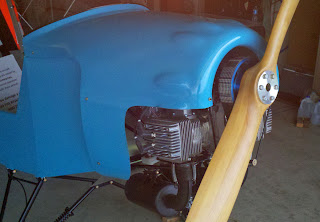Please note: James' blog has moved to a Wordpress site. To access it, please visit
http://jameswiebe.wordpress.com/. All posts have been transferred to the new site, and all new posts will only be accessible via Wordpress. Thank you for your interest!
It's easy to calculate the Center of Gravity in a Belite Ultralight Aircraft!
*** NOTE: This post is for taildraggers. I have posted an additional blog entry on how to calculate CG in a tricycle gear airplane. After reading this taildragger post, you can read the additional post on calculations for a
tricycle gear plane HERE. ***
1. Ensure that the aircraft has everything on board that should be in place for finding the empty weight and CG. Using a level, put a support under the tailwheel and make sure that the plane is level front to back and side to side. You'll need to lift the tailwheel off the floor by somewhere around 20 inches. The lower door line may be used as a level line. Here's what a level Belite looks like:
 |
| Belite Ultralight Airplane, Level, Side View |
2. With the aircraft level and all fixed equipment installed, record the scale readings and weights. The fuel tank should be empty.
Right Wheel = ____________ Pounds
Left Wheel = ____________ Pounds
Tailwheel = ____________ Pounds
3. Verify and recalculate as necessary, the ARMs for each wheel location. This is done relative to the forward face of the firewall. You can use a plumb bob from the firewall to mark the location on the ground, then measure back to the middle of the main wheels and the tailwheel.
Typical Main Wheel ARM = 20.6 inches (yours may vary)
Typical Tail Wheel ARM = 162.6 inches (yours may vary)
 |
| Measuring ARMS for CG calculation on ultralight aircraft |
|
|
We also need to know where the pilot is located and the fuel tank. For our sample airplane, we will assume 36.9 inches for the ARM of the pilot, and 58.6 inches for the ARM of the fuel. You are encouraged to verify these ARMs as well.
4. Now let's do some calculations on weights, ARMS, and moments. We'll add in the pilot weight, and also the weight of some fuel.
Weight, ARM, moment
Right Wheel 124.7 x 20.6 = 2568.8
Left Wheel 124.7 x 20.6 = 2568.8
Pilot 200.0 x 36.9 = 6273.0
Fuel 30.0 x 58.6 = 1758.0
Tailwheel 28.2 x 162.6 = 4585.3
And let's add up the weights and moments:
In this example, the weight adds up to 507.6 pounds (with gross aircraft weight of 550 pounds, so that's good) and the moments add up to 18861.0.
Dividing total moment by total weight, 18861 / 507.6 = 37.16. This means that the CG is 37.16 inches. Since our aircraft has a range of 34.5 to 39.1, we are good to fly.
5. Further exercises.
You'll want to determine CG at a variety of pilot weights (to match your own weight) and fuel conditions. In our example airplane, the CG is 35.81 at a zero fuel condition, so the CG moves forward as fuel is consumed.






















